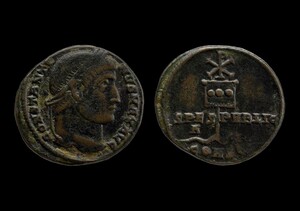Short Teaching Module: Constantine and Christianity
Overview
Christianity is based on the teachings of Jesus of Nazareth (ca. 3 B.C.E.–29 C.E.), a Jewish religious thinker who according to Christian Scripture lived in Judaea, a province of the Roman Empire. Accounts of his life and teachings spread orally and then in writing, among men and women from all social classes. Initially largely ignored and then sporadically persecuted, Christians grew in number. In the early fourth century, the Roman Emperor Constantine (r. 306-337) began to support Christianity, hoping it could be a unifying force in an empire plagued by problems. The sources in this module provide evidence for some of Constantine’s actions, which laid the foundation for a later growth in church power. The primary sources referenced in this module can be viewed in the Primary Sources folder below. Click on the image or texts for more information about the source.
This short teaching module includes guidance on introducing and discussing the three primary sources.
Essay
The teachings of Jesus spread throughout the Roman Empire in the first several centuries after his life, through intentional missionary work, family contacts, friendships, and business networks. Roman authorities initially ignored Christianity, seeing it as a sect within Judaism and therefore of little consequence. Some Roman governors and emperors persecuted his followers, including torture and executions, but most of these persecutions were local and sporadic and they did not slow the spread of Christian ideas and practices. These persecutions may have actually helped Christianity spread, as the heroism of martyrs often impressed those who watched their public executions and who later became Christians themselves.
As the number of converts increased, permanent institutions were established, including large buildings for worship and a hierarchy of officials—priests, bishops, archbishops—often modeled on those of the Roman Empire. Bishops and theologians began to develop complex interpretations of issues that were not clear in early texts, often drawing on Greek philosophy and Roman legal traditions. They also modified Jesus’ teachings about wealth, power, and family, downplaying those that seemed socially disturbing and bringing them more in line with Roman values. Christianity became more formal , bureaucratic, and centralized.
The third century brought civil war, invasions, and economic chaos to the Roman Empire. Hoping that Christianity could be a unifying force in an empire plagued by problems, Emperor Constantine ordered toleration of all religions in the Edict of Milan, issued in 313. He supported the Christian Church throughout his reign, expecting in return the support of church officials in maintaining order, and late in his life he was baptized as a Christian. There is great disagreement among historians about how much of the Roman population had become Christian by the time of Constantine, but it was certainly a sizable minority.
Constantine freed the clergy from imperial taxation, called and appeared at councils that decided theological issues, and endowed the building of Christian churches, especially in the new capital he was building for the Roman Empire at Byzantium, an old Greek city on the Bosporus, a strait on the boundary between Europe and Asia. He named the city the “New Rome,” though it was soon called Constantinople. Constantine also declared Sunday a public holiday, choosing it over the Jewish holy day of Saturday because it fit with his own worship of the sun god, a practice shared by many Romans. The annual celebration of the birthday of Jesus was set at midwinter, when Romans were already celebrating the rebirth of the Sun at the winter solstice. Thus Roman religious traditions were assimilated into Christianity. Christians altered their practices to follow the emperor’s decrees; worship became increasingly elaborate, and clergy began to wear ornate clothing and use expensive symbols of authority modeled on those of emperor.
Some Christians objected to these close connections between church and state, wondering if Christianity could be both powerful and holy. Men and women who thought this way sometimes left cities and went into the Egyptian desert to live as ascetics, or formed themselves into monastic communities somewhat cut off from the world, similar to the monasteries that emerged in Buddhism.
Helped in part by its favored position, Christianity slowly became the leading religion in the empire, and emperors after Constantine continued to promote it. In 380 the emperor Theodosius (r. 379-395) made Christianity the official religion of the Roman Empire. He allowed the church to establish its own courts and to use its own body of law, called “canon law.” With this he laid the foundation for later growth in church power.
Why I Teach These Sources
Religions are often taught in world history as a matter of core teachings —Buddhists believe this, Christians believe this, Muslims believe this—that disconnect them from their historical development and tend to flatten them into “timeless truths.” When I teach about religion, I try to focus on the human actors involved, and the way religious beliefs, ideas, rituals, and institutions changed and developed. This is particularly important for what are often called “universal religions” or “portable religions”—religious traditions not identified with particular locations or ethnic groups, but that appealed across cultural boundaries to spread widely and often become very diverse. Migrations, invasions, trade, and intentional missionary work carried religious ideas and practices from place to place, and they became transformed in the process. Every religious tradition began as a local one, and to help students understand how some became “universal,” they need to know about the actions of rulers such as Constantine, as religion and politics have always been intertwined.
Some of the students in your class may well attend churches in which they see aspects of worship that developed during Constantine’s reign every Sunday, including clerical vestments, communion chalices, golden candelabra, and religious images. Even in Christian churches that have none of these, the fact that worship is on Sunday rather than Saturday was Constantine’s decision.
How I Introduce These Sources
Whenever I introduce the first written source about religion or spirituality to my students, I talk over some of the ways that studying the history of any religious movement can pose special problems for historians. We may have more trouble achieving unbiased assessments of the history of religion than of other historical topics because of our intellectual, spiritual, or emotional commitments to certain religious ideas. I try to make clear that our job as historians is to understand people’s religious ideas within their historical context and to see how religious faith has manifested itself in historically observable phenomena; it is not to judge whether certain religious ideas are right or wrong, true or false.
I stress that difficulties in being objective when studying the history of religion can stem not only from our own personal religious commitments, but also from the nature of the sources available. Very few religious sources were written simply to describe what happened; more often, they were written to express central doctrines or to win converts. Even those sources that do describe historical events, such as the actions of the political leaders, were often written for the added purpose of spreading the faith. Many of these were composed long after the events occurred, and so later developments colored the ways in which they were recorded. In some cases, these written records were based on extensive oral traditions, but they are now our only source for the events they describe, and we have no way to check their accuracy. They may relate events that were viewed at the time as clearly miraculous—visions in the sky, voices from heaven—but also as having actually happened. I emphasize that luckily, we as historians do not need to take a stand on the historicity of such events. What is important for us is that people believed that they had happened and acted accordingly.
I note that in talking about any religious group, we often make distinctions between history, tradition, and myth, but the lines between these are never sharp and are frequently contested. It is important to recognize, however, that tradition and myth are not the same; when historians use the phrase “according to tradition, . . . ” they are not saying that an event is completely mythological but simply commenting on the limits of their sources.
Primary Sources
Credits
Merry Wiesner-Hanks is Distinguished Professor of History at the University of Wisconsin-Milwaukee. She is the long-time senior editor of the Sixteenth Century Journal, an editor of the Journal of Global History, and the editor-in-chief of the nine-volume Cambridge World History (2015). She is an author or editor of more than thirty books and nearly 100 articles that have appeared in English, German, French, Italian, Spanish, Portuguese, Greek, Chinese, Turkish, and Korean.


